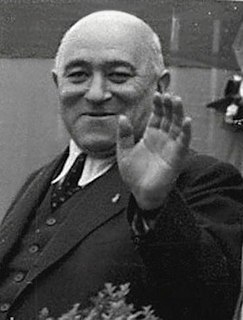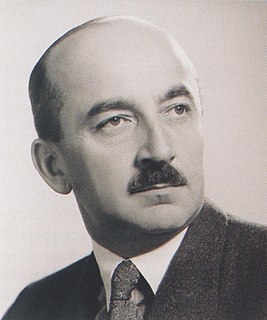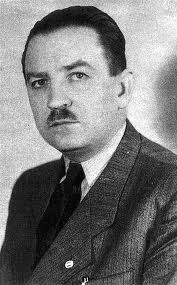
János József Kádár, born János József Czermanik, was a Hungarian communist leader and the General Secretary of the Hungarian Socialist Workers' Party, a position he would serve in for 32 years. Declining health led to his retirement in 1988, and he would die a year later in 1989.

Petru Groza was an Austro-Hungarian-born Romanian politician, best known as the first Prime Minister of the Communist Party-dominated government under Soviet occupation during the early stages of the Communist regime in Romania, and later as the President of the Presidium of the Great National Assembly from 1952 until his death in 1958.

Ernő Gerő was a Hungarian Communist leader in the period after World War II and briefly in 1956 the most powerful man in Hungary as the second secretary of its ruling communist party.

Mátyás Rákosi was a Hungarian communist politician who was the de facto leader of Hungary from 1947 to 1956. He served first as General Secretary of the Hungarian Communist Party from 1945 to 1948 and then as General Secretary of the Hungarian Working People's Party from 1948 to 1956.

István Dobi was a Hungarian politician who was Prime Minister of Hungary from 1948 to 1952 and Chairman of the Presidential Council of the Hungarian People's Republic from 1952 to 1967.

Ferenc Nagy was a Hungarian politician of the Smallholders Party who served as Prime Minister of Hungary from 1946 until his forced resignation in 1947. He was also a Speaker of the National Assembly of Hungary and a member of the High National Council from 1945 to 1946. Nagy was the second democratically elected prime minister of Hungary, and would be the last until 1990 not to be a Communist or fellow traveler. The subsequent Hungarian prime minister Imre Nagy was unrelated to him.

The Independent Smallholders, Agrarian Workers and Civic Party, known mostly by its acronym FKgP or its shortened form Independent Smallholders' Party, is a political party in Hungary. Since the 2002 parliamentary elections, the party has won no seats.

Parliamentary elections were held in Poland on 19 January 1947, the first since World War II. According to the official results, the Democratic Bloc, dominated by the communist Polish Workers Party (PPR) and also including the Polish Socialist Party (PPS), People's Party (SL), Democratic Party (SD) and non-partisan candidates, gained 80.1% of the vote and 394 of the 444 seats in the Legislative Sejm. The largest opposition party, the Polish People's Party, was officially credited with 28 seats. However, the elections were characterized by violence; anti-communist opposition candidates and activists were persecuted by the Volunteer Reserve Militia (ORMO). The results were blatantly falsified; the opposition claimed that it would have won in a landslide had the election been conducted in a fair manner.

The Hungarian People's Republic was a one-party socialist state from 20 August 1949 to 23 October 1989. It was governed by the Hungarian Socialist Workers' Party, which was under the influence of the Soviet Union. Pursuant to the 1944 Moscow Conference, Winston Churchill and Joseph Stalin had agreed that after the war Hungary was to be included in the Soviet sphere of influence. The HPR remained in existence until 1989, when opposition forces brought the end of communism in Hungary.

General elections were held in Romania on 19 November 1946, in the aftermath of World War II. The official results gave a victory to the Romanian Communist Party (PCR), its allies inside the Bloc of Democratic Parties, together with its associates, the Hungarian People's Union and the Democratic Peasants' Party–Lupu. The event marked a decisive step towards the disestablishment of the Romanian monarchy and the proclamation of a Communist regime at the end of the following year. Breaking with the traditional universal male suffrage confirmed by the 1923 Constitution, it was the first national election to feature women's suffrage, and the first to allow active public officials and army personnel the right to vote. The BPD, representing the incumbent leftist government formed around Prime Minister Petru Groza, was an electoral alliance comprising the PCR, the Social Democratic Party (PSD), the Ploughmen's Front, the National Liberal Party–Tătărescu (PNL–Tătărescu), the National Peasants' Party–Alexandrescu (PNȚ–Alexandrescu) and the National Popular Party.
Parliamentary elections were held in Hungary on 4 November 1945. They came at a turbulent moment in the country's history: World War II had had a devastating impact; the Soviet Union was occupying it, with the Hungarian Communist Party growing in numbers; a land reform that March had radically altered the property structure; and inflation was rampant.
Parliamentary elections, which later became known as the "blue-ballot" elections, were held in Hungary on 31 August 1947. The Hungarian Communist Party, which had lost the previous election, consolidated its power in the interim using salami tactics. Communist-led political intrigues had deprived their opposition of its democratically won mandate from 1945, as numerous prominent anti-Communists were removed from office on charges of conspiracy. These conspiracies reached a climax in late May 1947, when the Hungarian Communist Party deposed the democratically elected prime minister Ferenc Nagy in a coup d'état, removing one of the strongest opponents to their rule and crippling the opposition. This weakening of the opposition, combined with a revised electoral law, led to further Communist gains. This would be the last remotely competitive election held in Hungary until 1990.
Parliamentary elections were held in Hungary on 15 May 1949. The Hungarian Independent People's Front, an umbrella group created that February to replace the National Independence Front and led by the Hungarian Working People's Party, but also including the remaining four non-communist parties, ran a single list of candidates espousing a common programme. With all organised opposition having been paralysed, the Front won 95.6% of the vote, presaging the result of elections through 1990. 71 (17.7%) elected deputies were female, up from 22 (5.4%) elected in 1947. Some 71% of those elected belonged to the Working People's Party, and a similar proportion were workers or peasants.

The Second Hungarian Republic was a parliamentary republic briefly established after the disestablishment of the Kingdom of Hungary on 1 February 1946 and was itself dissolved on 20 August 1949. It was succeeded by the Hungarian People's Republic.
In the May 1947 crises, the Communists were excluded from government in Italy and France. The crises contributed to the start of the Cold War in Western Europe.
Hungary in its modern (post-1946) borders roughly corresponds to the Great Hungarian Plain . During the Iron Age, it was located at the crossroads between the cultural spheres of the Celtic Tribes, Dalmatian Tribes and the Germanic Tribes.

Béla Kovács was a Hungarian politician, who served as Minister of Agriculture from 1945 to 1946 and in the Hungarian Revolution of 1956.
The Independent Hungarian Democratic Party was a political party in Hungary in the period after World War II. The party was revived after the end of communism in 1989–90, but remained unsuccessful.
The Eastern Bloc is a collective term for the former Communist countries in Central and Eastern Europe. This generally encompasses the Soviet Union and the countries of the Warsaw Pact.
The Hungarian Freedom Party, was a short-lived right-wing political party in Hungary between 1946 and 1947, it strongly opposed the Communist takeover. The party was revived for a short time during the Hungarian Revolution of 1956 and after the end of communism in 1989–90.











